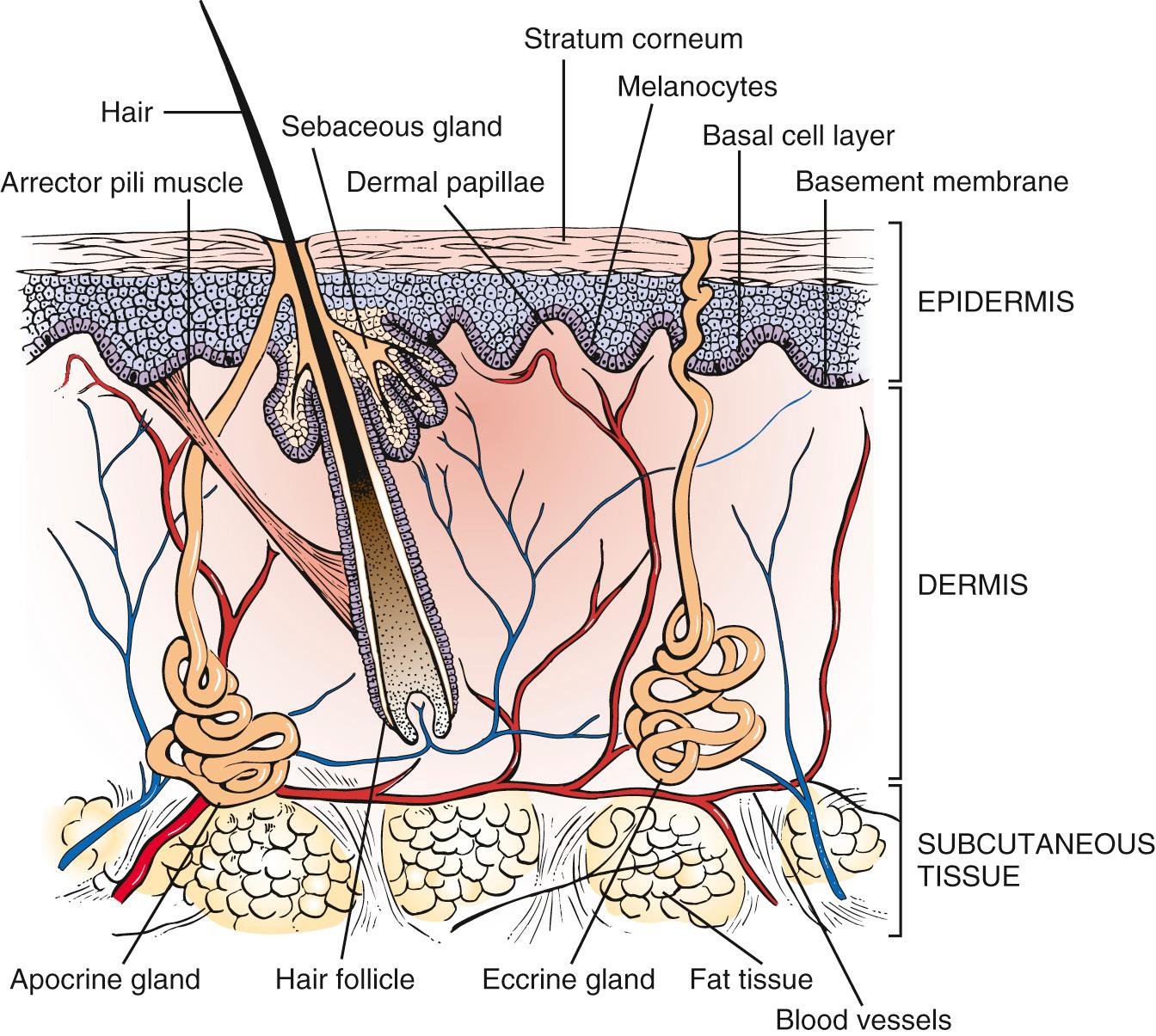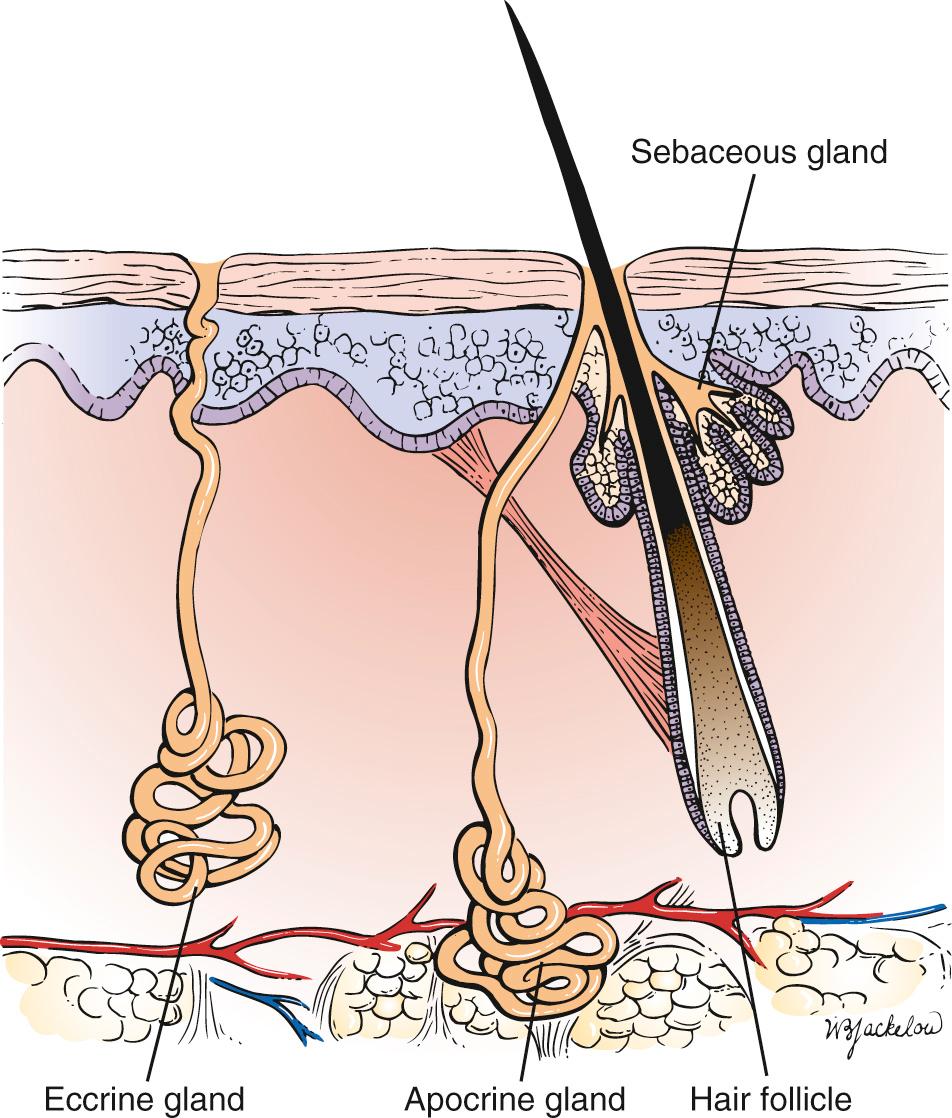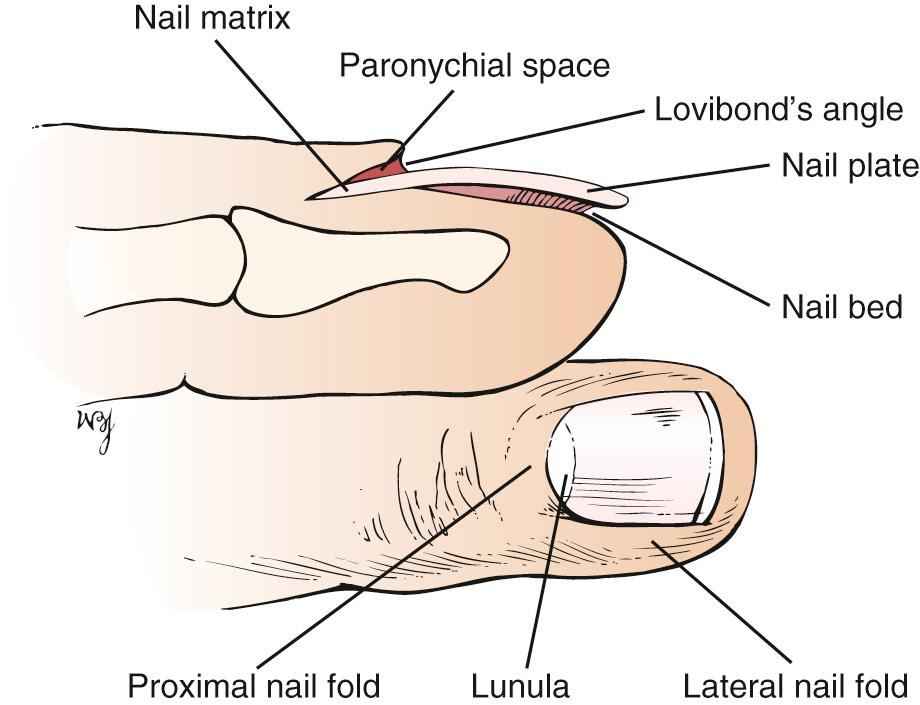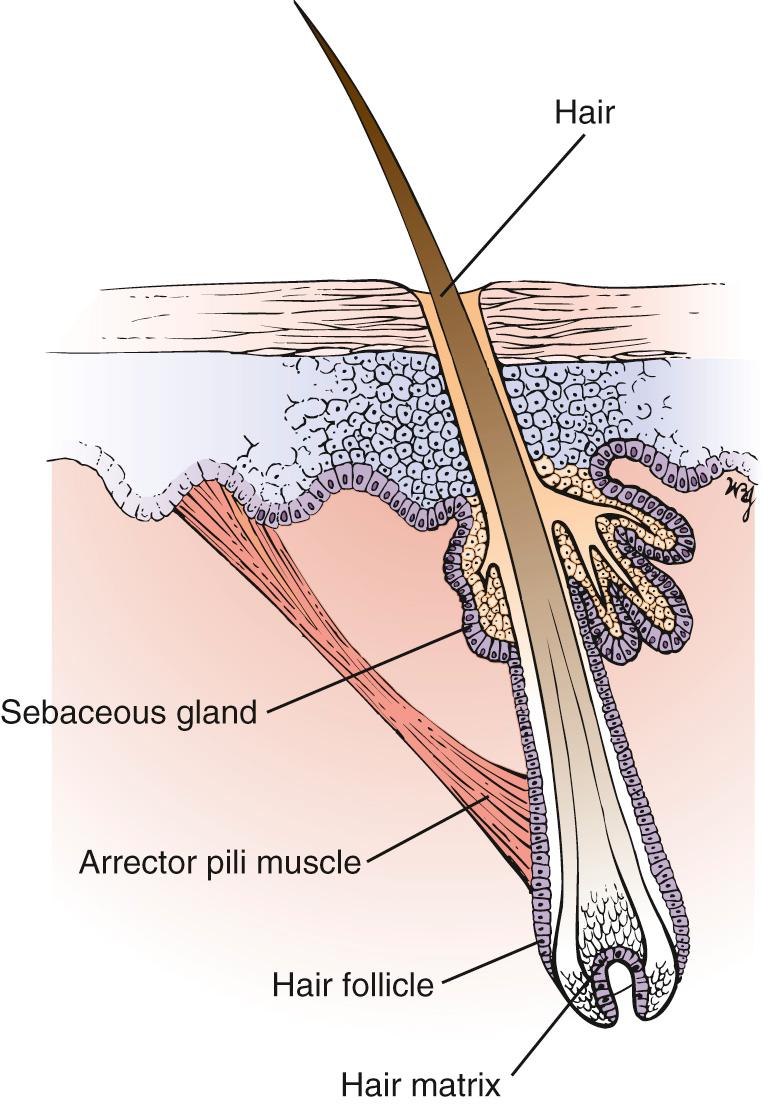Physical Address
304 North Cardinal St.
Dorchester Center, MA 02124
The skin, which is the largest organ of the body, is one of the best indicators of general health. Even a person without medical training is capable of detecting changes in skin color and texture. The trained examiner can detect these changes and at the same time evaluate more subtle cutaneous signs of systemic disease.
Diseases of the skin are common. Approximately one-third of the population in the United States has a disorder of the skin that warrants medical attention. Nearly 8% of all adult outpatient visits are related to dermatologic problems. Basal cell carcinomas and squamous cell carcinomas (i.e., nonmelanotic skin cancers [NMSCs]) are by far the most common malignancies that occur in the United States. One of every three new cancers is a skin cancer, and the vast majority are basal cell carcinomas. Approximately 80% of the new skin cancer cases are basal cell carcinoma, 16% are squamous cell carcinoma, and 4% are melanoma. Most of these cases occur on the head and neck, which is evidence of the importance of sun exposure as a causative stimulus. Squamous cell carcinoma, the second most common skin cancer after basal cell carcinoma, afflicts more than 200,000 Americans each year. Although in most of these patients the cancer is treated and cured, skin cancer still causes more than 5000 deaths a year.
Melanoma is responsible for most skin cancer deaths, although it accounts for less than 5% of all skin cancer cases. There were 91,270 new cases of melanoma in 2018: 55,150 in men and 36,120 in women. The incidence of malignant melanoma is rising at a rate faster than that of any other tumor; it has more than tripled among white persons between 1980 and 2018. Melanoma was responsible for 9320 total deaths in 2018: 5990 men and 3320 women. In 2018 the lifetime risk of developing melanoma (invasive and in situ) in white persons was 2.6%; the lifetime risk was 0.1% in African Americans. Since 1992, incidence rates among white individuals have increased by 2.8% per year in both men and women. The reasons for this are unclear, but excessive sun exposure is a major factor. European Americans are at highest risk; they have a 10 times higher risk than African Americans. The risk of melanoma increases as people age. The average age of people when melanoma is diagnosed is 63 years of age, but melanoma is not uncommon even among those younger than 30. In fact, it is one of the most common cancers in young adults, especially young women.
Early detection and treatment of malignant melanoma, as with most cancers, offers the best chance of a cure. Both basal cell carcinoma and squamous cell carcinoma have a better than 99% cure rate if detected and treated early. Among patients with a superficial melanoma (<0.76 mm in depth), the 5-year survival rate is more than 95%, whereas among those with a larger lesion (>3.64 mm in depth), the 5-year survival rate is less than 40% because these cancers are more likely to spread to other parts of the body. The external nature of melanoma gives the examiner an opportunity to detect these small, potentially more curable, lesions.
The most important function of the skin is to protect the body from the environment. The skin has evolved in humans to be a relatively impermeable surface layer that prevents the loss of water, protects against external hazards, and insulates against thermal changes. It is also actively involved in the production of vitamin D. The skin appears to have the lowest water permeability of any naturally produced membrane. Its barrier to invasion retards potentially noxious agents from entering the body and causing internal damage. This barrier protects against many physical stresses and prohibits the invasion of microorganisms. By observing patients with extensive skin problems, such as burns, clinicians can appreciate the importance of this organ.
The three tissue layers of the skin, depicted in Fig. 8.1 , are as follows:
Epidermis
Dermis
Subcutaneous tissue

The epidermis is the thin, outermost layer of the skin. It is composed of several layers of keratocytes, or keratin-producing cells. Keratin is an insoluble protein that provides the skin with its protective properties. The stratum corneum is the outermost layer of the epidermis and serves as a major physical barrier. The stratum corneum is composed of keratinized cells, which appear as dry, flattened, anuclear, and adherent flakes. The basal cell layer is the deepest layer of the epidermis and is a single row of rapidly proliferating cells that slowly migrate upward, keratinize, and are ultimately shed from the stratum corneum. The process of maturation, keratinization, and shedding takes approximately 4 weeks.
The cells of the basal layer are intermingled with melanocytes , which produce melanin . The number of melanocytes is approximately equal in all people. Differences in skin color are related to the amount, size of particles, and type of melanin produced, as well as to its dispersion in the skin. Skin color is due primarily to the presence of a pigment called melanin, which is controlled by at least six genes. Both light- and dark-complexioned people have melanin. However, two forms of melanin are produced: pheomelanin, which is red to yellow in color, and eumelanin, which is dark brown to black. People with light-complexioned skin mostly produce pheomelanin, whereas those with dark-colored skin mostly produce eumelanin. Melanocytes have photosensitive receptors, similar to those in the eye, that detect ultraviolet radiation from the sun and other sources. In response, they produce melanin within a few hours of exposure.
Beneath the epidermis is the dermis, which is the dense connective tissue stroma forming the bulk of the skin. The dermis is bound to the overlying epidermis by fingerlike projections that project upward into the corresponding recesses of the epidermis. In the dermis, blood vessels branch and form a rich capillary bed in the dermal papillae. The deeper layers of the dermis also contain the hair follicles with their associated muscles and cutaneous glands. The dermis is supplied with sensory and autonomic nerve fibers. The sensory nerves end either as free endings or as special end organs that mediate pressure, touch, and temperature. The autonomic nerves supply the arrector pili muscles, blood vessels, and sweat glands.
The third layer of the skin is the subcutaneous tissue, which is composed largely of fatty connective tissue. This highly variable adipose layer is a thermal regulator, as well as a protection for the more superficial skin layers from bone prominences.
The sweat glands, hair follicles, and nails are termed skin appendages. The evaporation of water from the skin by the sweat glands provides a thermoregulatory mechanism for heat loss. Fig. 8.2 illustrates the types of sweat glands.

Within the skin, there are 2 to 3 million small, coiled eccrine glands. The eccrine glands are distributed over the body surface and are particularly profuse on the forehead, axillae, palms, and soles. They are absent in the nail beds and in some mucosal surfaces. These glands are capable of producing more than 6 L of watery sweat in 1 day. The eccrine glands are controlled by the sympathetic nervous system.
The apocrine glands are larger than the eccrine glands. The apocrine glands are found in close association with hair follicles but tend to be much more limited in distribution than are the eccrine glands. The apocrine glands occur mostly in the axillae, the areolae, the pubis, and the perineum. They reach maturity only at puberty, secreting a milky, sticky substance. Apocrine glands are adrenergically mediated and appear to be stimulated by stress.
The sebaceous glands are also found surrounding hair follicles. The sebaceous glands are distributed over the entire body; the largest glands are found on the face and upper back. They are absent on the palms and soles. Their secretory product, sebum, is discharged directly into the lumen of the hair follicle, where it lubricates the hair shaft and spreads to the skin surface. Sebum consists of sebaceous cells and lipids. The production of sebum depends on gland size, which is directly influenced by androgen secretion.
Nails protect the tips of the fingers and toes against trauma. They are derived by keratinization of cells from the nail matrix, which is located at the proximal end of the nail plate. The nail plate consists of the nail root embedded in the posterior nail fold, a fixed middle portion, and a distal free edge. The whitish nail matrix of proliferating epithelial cells grows in a semilunar pattern. It extends outward past the posterior nail fold and is called the lunula. The structural relationships of the nail are shown in Fig. 8.3 .

A hair shaft is a keratinized structure that grows out of the hair follicle. Its lower end, called the hair matrix, consists of actively proliferating epithelial cells. The cells at this end of the follicle, along with those of the bone marrow and gut epithelium, are the most rapidly growing dividing cells in the human body. This is the reason that chemotherapy causes hair loss, along with anemia, nausea, and vomiting. Visible hair is present over the entire body surface except on the palms, soles, lips, eyelids, glans penis, and labia minora. In apparently hairless areas, the hair follicles are small and the shafts produced are microscopic. Hair follicles show conspicuous morphologic and functional heterogeneity. Follicles and their developing shafts differ from location to location in shaft length, color, thickness, curl, and androgen sensitivity. Some follicles, those in the axilla and inguinal areas, are very sensitive to androgens, whereas those in the eyebrow are insensitive. The arrector pili muscles attach to the follicle below the opening of the sebaceous gland. Contraction of this muscle erects the hair and causes “goose bumps.” The structure of a hair follicle is shown in Fig. 8.4 .

The main symptoms of disease of the skin, hair, and nails are the following:
Rash or skin lesion
Changes in skin color
Itching (pruritus)
Changes in hair
Changes in nails
There are some important points to clarify when a patient is interviewed about a new rash or skin lesion. The specific time of onset and location of the rash or skin lesion are critical. A careful description of the first lesions and any changes is vital. The patient with a rash or skin lesion should be asked the following questions:
“Was the rash initially flat? Raised? Blistered?”
“Did the rash change in character with time?”
“Have there been new areas involved since the rash began?”
“Does the rash itch or burn?”
“Is the lesion tender or numb?”
“What makes the rash better? Worse?”
“Was the rash initiated by sunlight?”
“Is the rash aggravated by sunlight?”
“What kind of treatment have you tried?”
“Do you have any joint pains? Fever? Fatigue?”
“Does anyone near you have a similar rash?”
“Have you traveled recently?” If so, “To where?”
“Have you had any contact with anyone who has had a similar rash?”
“Is there a history of allergy?” If so, “What are your symptoms?”
“Do you have any chronic disease?”
Note whether the patient has used any medications that may have changed the nature of the skin disorder.
Inquire whether the patient uses any prescription medications or over-the-counter drugs. Ask specifically about aspirin and aspirin-containing products. Patients can suddenly develop a reaction to medications that they have taken for many years. Do not ignore a long-standing prescription. Has the patient had any recent injections or taken any new medications? Does the patient use “recreational” drugs? Ask the patient about the use of soaps, deodorants, cosmetics, and colognes. Has the patient changed any of these items recently?
A family history of similar skin disorders should be noted. The effect of heat, cold, and sunlight on the skin problem is important. Could there be any contributing factor, such as occupation, specific food allergies, alcohol, or menses? Is there a history of gardening or household repair work? Has there been any contact with animals recently? The interviewer should also remember to inquire about psychogenic factors that may contribute to a skin disorder.
Determine the patient's occupation, if it is not already known. Ascertain any avocational and recreational activities. This information is important even if the patient has been exposed to chemicals or similar agents for years. Manufacturers frequently change the basic constituents without notifying the consumer. It may also take years for a patient to become sensitized to a substance.
Patients may complain of a generalized change in skin color as the first manifestation of an illness. Cyanosis and jaundice are examples of this type of problem. Determine whether the patient is aware of any chronic disease that may be responsible for these changes. Localized skin color changes may be related to aging or to neoplastic changes. Certain medications can also be responsible for skin color changes. Inquire whether the patient is taking or has recently taken any medications.
Pruritus, or itching, may be a symptom of a generalized skin disorder or an internal illness. It can be associated with diabetes, dry skin, skin disorders, thyroid disease, parasites, arthropod bites, pregnancy, inflammatory disorders, and cancer. Histamine is one of the most important mediators of itch, although other chemical substances have also been implicated. Ask any patient with pruritus the following questions:
“When did you first notice the itching?”
“Did the itching begin suddenly?”
“Is the itching associated with any rash or lesion on your body?”
“Are you taking any medications?…such as antibiotics?…pain medications?”
“Has there been any change in the sweating or dryness of your skin?”
“Have you noticed any color changes to your skin?”
“Have you been told that you have a chronic illness like liver disease?…kidney disease?…diabetes?…HIV?”
“Have you traveled recently?” If so, “To where?”
If the patient is a woman, “Is it possible you might be pregnant?”
Diffuse pruritus is observed in biliary cirrhosis and in cancer, especially lymphoma. Many drugs have been associated with diffuse pruritus: antibiotics, allopurinol, amiodarone, angiotensin-converting enzyme inhibitors, estrogen, hydrochlorothiazide, opioids, and statins. Pruritus in association with a diffuse rash may be dermatitis herpetiformis. Determine whether the pruritus has been associated with a change in perspiration or dryness of the skin because either of these conditions may be the cause of the pruritus.
Inquire whether there has been a loss of hair or an increase in hair. Ascertain any changes in distribution or texture. If there have been changes, ask the following questions:
“When did you first notice the changes?”
“Did the change occur suddenly?”
“Is the hair loss symmetric?”
“Has the change been associated with itching? Fever? Recent stress?”
“Are you aware of any exposure to any toxins? Commercial hair compounds?”
“Have you changed your diet?”
“What medications are you taking?”
Changes in diet and medications are frequently responsible for changes in hair patterns. Hypothyroidism is frequently associated with loss of the lateral third of the eyebrows. Vascular disease in the legs often causes hair loss on the legs. Alternatively, ovarian and adrenal tumors can cause an increase in body hair.
Changes in nails may include splitting, discoloration, ridging, thickening, or separation from the nail bed. Ask the patient the following questions:
“When did you first notice the nail changes?”
“Have you had any acute illness recently?”
“Do you have any chronic illness?”
“Have you been taking any medications?”
“Have you been exposed to chemicals at work or at home?”
Fungal disease causes thickening of the nail. Clues to systemic disease may be found by close examination of the proximal nail fold, the lunula, the nail bed, the nail plate, and the hyponychium. Acute illnesses are associated with lines and ridges in the nail bed and nail. Medications and chemicals are notorious for causing nail changes.
Become a Clinical Tree membership for Full access and enjoy Unlimited articles
If you are a member. Log in here